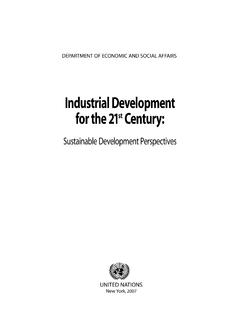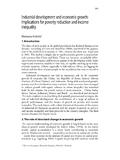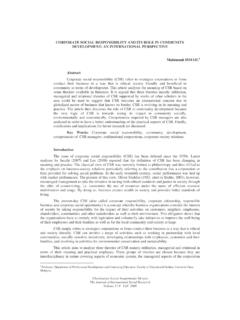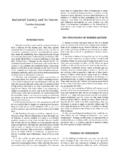Transcription of Adjusting Structural Adjustment: The Role of the ...
1 Adjusting Structural adjustment : the role of the Structural adjustment Program in Africa's development Tabisa Walwema April 1, 2013. Professor Francis Ssekandi Major Writing Requirement Tabisa Walwema Structural adjustment Programs in Africa Introduction In 1980, the President of the World Bank, Robert McNamara sought and received approval from the World Bank Board to launch a new instrument: the Structural adjustment loan. 1 In his mind, the World Bank would use its loans to provide finance to borrower-countries over a limited amount of years. In return for the finance program, the borrower-country would implement specified trade reforms and price incentives for resource allocation all in an effort to achieve the goals of the World Bank and IMF. 2 The specific objectives of the program were to reduce [a developing country's] current account deficit to more manageable proportions by supporting programs of adjustment .
2 To strengthen their balance payments while maintaining growth and development momentum. 3. This paper seeks to address two key areas of analysis the impact of trade liberalization as an effective fiscal policy, and the effect of the Structural adjustment loan on government expenditures for public services. The paper argues that Structural adjustment loans have detrimentally affected the African people because trade liberalization does not comport with an efficient African economic system. The paper also argues that adherence to strict program standards has siphoned funds from public sector services. Due to lack of infrastructure, abundance in corruption, and inadequate democratic institutions; attempted program compliance did not create an African middle class, but rather exacerbated many of Africa's problems. 1. For the purposes of this paper, Structural adjustment loan and Structural adjustment program will be used interchangeably.
3 2. William Easterly, What Did Structural adjustment Adjust: The Association of Policies and Growth with Repeated IMF and World Bank adjustment loans, J. DEV. ECON. 1 (2005) [hereinafter Easterly](citing Devesh Kapur, John P. Lewis, Richard Web, The World Bank: Its First Half Century, Volume I: The History, The Brookings Institution, Washington, DC (1997). 3. Id. at 1. 1. Tabisa Walwema Part I: Structural adjustment Programs The Purpose, Structure, and Effect The IMF and World Bank History Even though considerable factors stood in the way of Africa's economic success, key players such as the United Nations ( UN ), the International Monetary Fund ( IMF ) and the World Bank, concentrated on alleviating African poverty. Policy was geared towards achieving economic stability and the creation of an African middle class. As a result, the Structural adjustment program found its birth in international forums and not in African legislatures.)
4 Structural adjustment [loans] .. entail the implementation of a set of macroeconomic and microeconomic policy reform measures to create an environment .. conducive to growth and development . 4 Countries utilizing a Structural adjustment loans and grants must implement policy changes based on macroeconomic reforms, deregulation of markets and prices, and trade liberalization. 5. While in practice, Structural adjustment programs appear to apply the western notions of economic success, one expert articulates that, a renewed interest in development of [compliant]. African countries has been prompted by less-than-satisfactory economic performance .. over the past two decades. 6 In addition, renewed interest in Africa's development tactic reflects efforts to assess the adjustment strategy espoused by the IMF and the World Bank. 7 Ultimately, years after Structural adjustment programs has been placed within the economic framework of 4.
5 Technoserve, Inc., Comparative Analysis of Structural adjustment Programs in Africa with emphasis on Agriculture and Trade, Regional Trade Agenda Series, 1995 available at (comparing the implications of Structural adjustment programs in a cross-border sample). 5. Id. 6. Michael T. Hadjimichael, Dhaneshwar Shura, Martin Muleisen, Roger Nord, and E. Murat Ucer, Sub-Sahran Africa Growth, Savings and Investment, 1986-1993, International Monetary Fund, Washington , Jan. 1995, 7. Id. 2. Tabisa Walwema the world's poorest continent, it is time to reassess and examine the program highlighting it's weaknesses, its strengths, and evaluating possible fiscal alternatives. Loan Program Description The World Trade Organization ( WTO ) describes structured adjustment programs as policies [which] reflect the neo-liberal ideology that drives globalization. 8 Even though programs wish sought long-term or accelerated economic growth in poorer countries by restructuring the economy and reducing government intervention, implementation resulted in currency devaluation, managed balance of payments, reduction of government services through public spending cuts, reducing tax on high earners, reducing inflation, privatization, lower tariffs on imports and tighter monetary policy, increased free trade, cuts in social spending, and business deregulation.
6 9 Consequently, Structural adjustment programs demand African countries liberalize their trade, level of development , and industrial base, in order to increase exports to foreign consumers and to allow for economic gain. 10 This resulted in governments surrendering their ability to influence their own economic and political agendas. The Beginning: Obtaining a Structural adjustment Loan The Structural adjustment program is essentially a conditional loan. The country in need (the borrower) approaches the IMF and World Bank (the lenders) for a loan. The lender services the loan based on the assumption that certain fiscal policies will take place within the borrow- country. The lender then requires that as a contingency, 11 national policies geared towards trade 8. The World Trade Organization Website available at 9. Id.; see also Finn Tarp, Stabilization and Structural adjustment : Macroeconomic Frameworks for Analysing the Crisis in Sub-Saharan Africa, 2 (Taylor and Francis e-library, 3rd ed.)
7 2001). 10. Elizabeth Justice, The African Union: Building a Dream to Facilitate Trade, development and Debt Relief, 12- SUM CURRENTS: INT'L TRADE 127 (2003) (explaining role of Structural adjustment programs play in the regional organization development ). 11. When a country borrows from the IMF, its government agrees to adjust its economic policies to overcome the problems that led it to seek financial aid from the international community. These loan conditions also serve to ensure that the country will be able to repay the Fund so that the resources can be made available to other members 3. Tabisa Walwema liberalization set the tone of the fiscal policies to be implemented by the borrower-country. A. borrower-country's compliance also meant possible decreases to already existing interest rates on IMF and World Bank loans. VG. In practice, Structural adjustment loans can be implemented in numerous ways.
8 This can be seen in the case of Cote d'Ivoire and China. A country may be a repetitive borrower, a selective borrow or a non-borrower. One of the first countries to participate in the program was Cote d'Ivoire. The country also became a repetitive Structural adjustment user (repetitive borrower) with 26 Structural adjustment loans. 12 Cote d'Ivoire represents the traditional transaction for Structural adjustment loan users. The World Bank describes the Cote d'Ivoire Loan stating that, The loan would be in support of the Government's program of Structural adjustment . The reforms envisaged by the program are designed to improve the level of public savings and the efficiency in the use of public resources;. restructure the agricultural, planning system and associated development institutions so that an expanded, well designed investment program yielding high returns can be mounted in the sector; reflect the costs of providing public services to the sector; assure that rational prices and world market conditions would guide decisions to invest and produce; restructure public enterprise, management, financing and accountability to ensure efficient market oriented operations; and restructure incentives, to promote efficient export-oriented industrial investments.
9 13. The language of the loan contingencies14 highlight the numerous market system policies the IMF pushed and promoted on borrowers. As mentioned before these policies include western style trade liberalization. in need. In recent years, the IMF has streamlined conditionality in order to promote national ownership of strong and effective policies. International Monetary Fund Website available at [hereinafter IMF Website](last updated Sept. 26, 2012). 12. William Easterly, IMF and World Bank Structural adjustment Programs and Poverty, National Bureau of Economic Research, Jan. 2001, 3 (citing the World Bank 8(a)). 13. Id. 14. See IMF Website, supra note 14. 4. Tabisa Walwema Another type of borrower was seen to be more successful. The selective borrowers15 did not borrow with the same frequency as repetitive borrowers. In China, the Structural adjustment program formed part of the reason the country established itself as a world player.
10 In 2012, it is almost unimaginable that one of the most important world actors relied on the Structural adjustment program. China has seen remarkable development and growth, so much so that it is now one of the largest owners of treasury In September of 2012 China owned approximately $ trillion in American China is now also one of the largest international players in the African economy. In July of this year, China announced it would invest $20 billion in loans to Africa, 18 and African exports to China have increased from $5 billion ten years ago to $93 billion. 19 What makes China a success and Cote d'Ivoire reliant on external funding? The Structural adjustment loans normally force the borrowing government to make adjustments in a few highly visible macroeconomic indicators, which primarily affect the formal sector of the economy. On the other hand, a homegrown reform program such as China's over the last 20 years as seen significant success.







